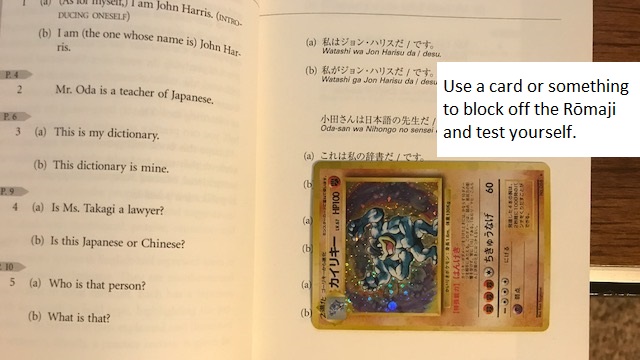I came across a little known book called Japanese Sentence Patterns for Effective Communication: A Self-Study Course and Reference by Taeko Kamiya.
I wanted to give my review on it, talking about some of the things that I like and dislike, so that other people can get a good idea of what the book is about.
If you’re interested in improving your everyday Japanese conversation skills, then read on to learn more about this book.
What is the Book About?
The book is based on a simple idea that almost no one talks about in the educational system for language learning. It’s one that I’ve found to be effective, especially for learning and remembering Japanese.
The concept in this book is that “language is nothing more than a series of patterns for communicating.”
Therefore, if you can recognize these reoccurring patterns, even when certain words within them are different, then you can understand what’s being said and then use those same patterns yourself to communicate back.
Let me illustrate with a pattern:
- これは私の辞書です。
- kore wa watashi no jisho desu.
- This is my dictionary.
This is a really simple sentence, but it also contains a very useful pattern. With this particular pattern you can declare every single thing that you own!
All you have to do is swap out the word 辞書 (dictionary) with anything else such as a car, house, or even things that you don’t necessarily own but that are connected to you in someway (such as a family member).
You could also change the word “my” in this pattern to “your, his, or her” to further increase the number of sentences you can use and understand.
Here’s the key point: all of those different phrases are really the same pattern, just with slight variations.
That allows us to create the following formula:
One pattern = dozens of useful sentences.
What happens when you know 2 patterns? How about 10? How about 100?
I think you get the point. This kind of pattern recognition starts compounding and you’re ability to communicate and comprehended Japanese sentences increases considerably.
Sometimes there are patterns that basically mean the same thing, but are phrased a little differently. We could call these “sub-patterns” if we wanted to.
For example, you could use an almost identical pattern to the one above as:
- この辞書は私のです。
- kono jisho wa watashi no desu.
- This dictionary is mine.
The meaning is basically the same, it’s just organized a little differently to highlight a different emphasis.
Let’s try out a totally different pattern now:
- このパイとそのパイと、どちらが甘いですか?
- kono pai to sono pai to, dochira ga amai desu ka?
- Which pie is sweeter, this pie or that pie?
Now you have a pattern that allows you to ask about comparisons!
Switch out the word “pie” to talk about different nouns. Switch out the word “sweet” to talk about different adjectives. Either way, it’s still the same pattern as before.
What is the Format of the Book?

The book teaches you a total of 142 patterns. Granted, some patterns have sub-patterns within them (like we saw before) that are similar enough to another pattern so they don’t get classified as their own.
So for the most part, you are actually going to learn more than 142 patterns, it’s just that some of them are really only slight variations.
The beginning of the book has all 142 patterns organized with the patterns in English listed on the left page and each of their corresponding Japanese patterns on the right page.
Then at the end of all the patterns it goes into chapters where the author dives into each of the patterns one by one, and explains the grammar associated with each, and anything else that you would need to know in order to gain a full understanding of the sentence.
It’s really beginner friendly, but I still found it useful when I was at the intermediate level.
This is great since the focus is on learning Japanese, and you only learn what grammar you need to at that point in time. It prevents confusion and overload that are common problems when you learn straight from grammar books.
Then there are some example sentences and new vocabulary that you look over before doing a short, but useful quiz at the end of the chapter.
I think that this quiz part is really insightful since studies have shown that people learn better when they are immediately tested on something, right after they just learned it.
What’s even better is that fact that the author asks “how would you say this phrases in Japanese?” and then gives you the English version.
This forces you to use anticipation and recall to provide the correct answers, which are way more effective method for solidifying information into your long-term memory as compared to other methods such as multiple choice questions.
Even though this type of testing is more difficult than the typical “choose the correct answer out of these options,” I feel it’s better to do the hard (but necessary) work now so that you get better results faster and can then move on to learn more things.
Two Downsides to This Book
Even though this book is fantastic, it still has (potentially) two drawbacks to it.
The first one is that there is no audio CD with it. It would have been really nice to have recordings of native speakers saying each pattern so that you could get a feel for the rhythm and flow of each sentence as a whole.
The book uses rōmaji to show the pronunciation of each word along with kanji/kana , but I don’t really like using rōmaji all that much since it tends to encourage people to use American (or English) accents to say Japanese words.
Perhaps the best way to overcome this would be to know hiragana and katakana first and then to work on memorizing the correct reading of each kanji as you encounter them.
Then you could go over each example sentence in the book and just cover up the rōmaji with something so that it doesn’t get in the way.
The second drawback only exists with digital copies of the book, so if you have a physical copy, then you don’t need to worry about it.
The format of the book is:
- Left page is all in English
- Right page is all in Japanese
But when you read it on a digital platform, you only see one page at a time.
That means that you are going to see 10 or so English phrases, and then you’re going to have to remember them when you scroll down a page and see the 10 corresponding phrases in Japanese.
If you don’t remember them exactly, you gotta’ scroll back up, re-memorize them, and then scroll back down to practice the Japanese version again.
The physical book doesn’t have this problem since you can easily look at one line on the left page with the English sentences and then move your eyes to the right page to see the matching Japanese phrases.
The solution to this problem is to get the paperback version if you can.
If not, just be aware that you’ll have to do a little extra work with the eBook format.
Where to Find It
Since I recommend people get a physical copy of the book, I think Amazon is the best place to purchase it.
That’s where I got mine, and it’s one of my favorite books on learning Japanese.
Have You Used This Book?
Anyway, those are my thoughts on it. What about you?
Have you used this book before? Do you have any other questions about it?
Let me know with a comment below!
Further Resources for Learning Japanese:
#3 Get My eBook (Secrets to Learning Japanese) for Free

またね!

I have been wanting to learn other languages for some time now. But I have been stuck on rather to invest in a program like Rosetta Stone or a booklet like you are talking about in this post. Could you point me in the right direction and which would you prefer for a beginner trying to learn a new language.
If you’re stuck on choosing between a course and a book that teaches a language, it would probably be better to go with the book since they tend to be cheaper. That way if it turns out that you don’t like the new language that much, you’ve only invested a little amount of money into it.